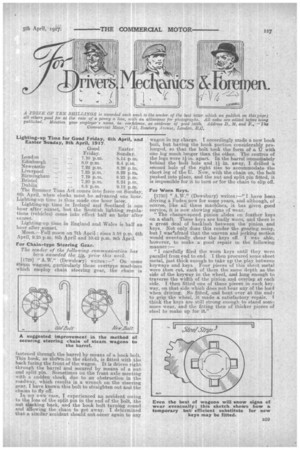Lighting-up Time for Good Friday, 6th April, and Easter Sunday, 8th April, 1917.
Page 21

If you've noticed an error in this article please click here to report it so we can fix it.
Good Easter Friday. .Sunday.
London 7.10 'p.m. 8.14 p.m. Edinburgh 8.0 p.m. 9.4 p.m. Newcastle 7.22 p.m. 8.26 p.m.
Liverpool...7.25 p.m. 8.29 p.m.
Birmingham ... ... 7.19 p.m. 8.2:3 p.m.
Bristol ... ... 7.20 p.m. 8.24 p.m. Dublin ... ... 8.8 p.m. 9.12 p.m.
The Summer Time Act comes into force on Sunday, 8th April, when clocks must be advanced one hour. Lighting-up time is thus made one hour latez. Lighting-up time in Ireland and Scotland is one hour after sunset, but the .eottish lighting. regula' tions. (vehicles) come into effect half an hour after an wet.
Lighting-up tune in England and Wales is half an hour after sunset. Moon.--Full moon on 7th April ; rises 5.58 p.m. 6th April, 9.25 p.m. 8th April and 10.42 p.m. 9th April.
For Chain-type Steering Gear.
The sender of the following communication has been awarded the,..40,.. prize this week[1729] " A.W." (Dewsbury) writes :—" On some Atam wagons, .particularly those overtype machines which employ chain steering gear, the chain is fastened through the barrel by means of a hook bolt. This hook, as shOwn sin the sketch, is fitted with the back facing the front of the wagon. It is driven right through the barrel and secured by meant of a nut and split pin. Sometimes on the front axle meeting with a sudden shock, due to an obstruction in the roadway, which results in a wrench on the steering gear. I have known this bolt to straighten out and the chains to fly off. In my own case, I experienced an accident owing to the loss of the split pin in the end of the bolt, the nut slacking back, and the hook bolt turning round and allowing the chain to get away. I determined that a similar accident should notoccur again to any
wagon in my charge. I accordingly made a new book bolt, but having the hook portion considerably prolonged, so that the bolt took the form of a TT with one leg much longer than the other. The centres of the legs were 1 in. apart. In the barrel immediately behind the bolt hole and 11.in, away, I drilled a second hole of the right size to accommodate the short leg of the IL Now, with the chain on, the bolt pushed into place, and the nut and split pin fitted, it is impossible for it to turn or for the chain to slip off.
For Worn Keys.
(1730] " A.W." (Dewsbury) writes :—" I have been driving a Foden now for some years, and although, of course, like all these machines, it has given good service, it is now showing signs of wear. "The change-speed pinion slides on feather keys on a shaft. These keys are badly worn, and there is a great deal of backlash between the pinion, and keys. Not only does this render the gearing noisy, but I wae afraid that the uneven and jerking motion would eventually shear the keys off. I was able, however, to make a good repair in the following manner :— "I carefully filed the worn keys until they were parallel from end to end. I then procured some sheet metal, just thick enough to take up the play between keyways and keys. Four pieces of this sheet metal were then cut, each of them the same depth as the side of the keyway in the wheel, and long enough to traverse the width of the pinion and overlap at each side. I then fitted one of these pieces in each keyway, on that side which does not bear any of the load when driving. .So fitted, and bent over at the end; to grip the wheel, it made a satisfactory repair. T think the keys are still strong enough to stand some more wear, and the fitting then of thicker pieces of steel to make up for it."






















